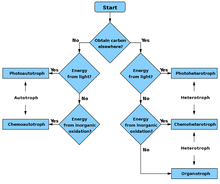Although there are three types of heterotrophs (creatures who, like humans, need to eat other living forms for energy), there are only two types of autotrophs: photoautotrophs and chemoautotrophs.

Photoautotrophs
These obtain sustenance by absorption of sunlight through the process of photosynthesis. This group includes green plants, who absorb sunshine through their leaves, algae and some bacteria. They produce the oxygen which we breathe.
Chemoautotrophs
These are organisms, typically bacteria or protozoa, who feed from inorganic (i.e. Non-carbon) sources in their immediate environment via oxidation. If you've ever seen a news report about life discovered in deep sea trenches near hydrothermal vents, these will be chemoautotrophs.
Another type of Autotroph?
Scientists are looking into the possibility that some types of fungi are able to convert radiation into energy for themselves. This means in the future, we may be able to add radiotrophs to the list of known autotrophs.
If you're still confused, or just have time to fill before you feed on organic matter for energy like a good heterotroph, this film will help you: